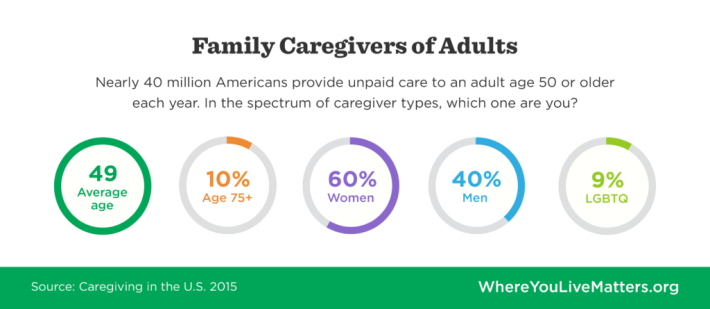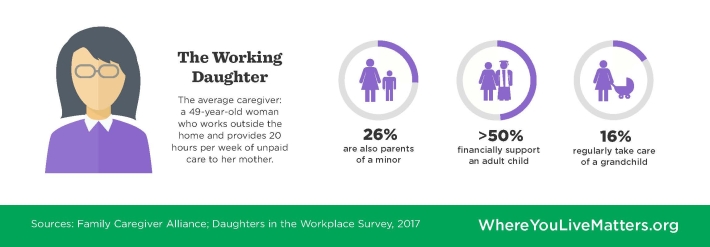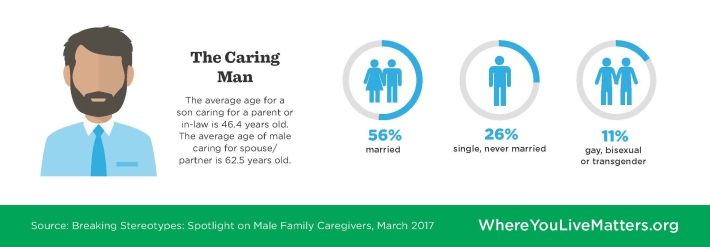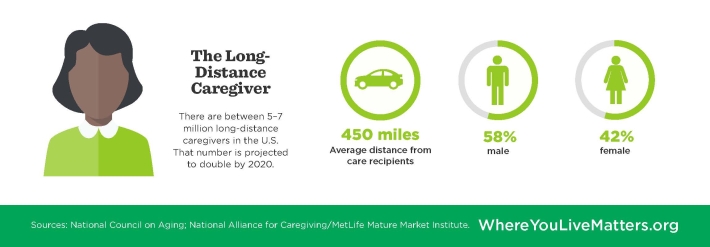Which Type of Caregiver Are You?
Check out our personas guide to learn which type of caregiver you are: the working daughter, caring man, spousal caregiver or long-distance caregiver.
Explore:
As a family caregiver, you’re part of a large group of folks taking care of an elderly parent or older spouse. In fact, nearly 40 million of you are providing unpaid care to an adult age 50 or older.
Who Are the Family Caregivers?
- 60% Women
- 40% Men
- 9% LGBTQ
The average age of a family caregiver is 49 — but nearly 10% are seniors themselves. Caregivers over the age of 75 are most likely taking care of a spouse or partner. Caregivers spend an average of 24.4 hours a week providing care, but 23% spend more than 41 hours per week caregiving.

The Working Daughter
The average caregiver overall is a 49-year-old woman who works outside the home and provides 20 hours per week of unpaid care to her mother. But like many in the sandwich generation, these working daughters support others as well:
- 26% are also parents of a minor
- More than 50% financially support an adult child
- 16% regularly take care of a grandchild

The Caring Man
The number of men becoming primary caregivers is rising. In the U.S., 40% of caregivers are men, while in the U.K. that number is 42%. The average age for a son caring for a parent or in-law is 46.4 years old. Men caring for spouse/partner are typically 62.5 years old. Male family caregivers help with an average of 1.7 activities of daily living (ADLs), as well as help manage finances, shopping, cooking and/or transportation.
- 56% married
- 26% single, never married
- 11% gay, bisexual or transgender

Spousal/Partner Caregivers
One in 10 family caregivers provide care for a spouse or partner, and the average caregiver age is 62. The typical caregiver over the age of 75 is a 79-year-old white, unemployed woman providing care to a 77-year-old male spouse or partner with Alzheimer’s, heart disease or age issues.
The Long-Distance Caregiver
Most family caregivers live within 20 minutes of their loved one. But not everyone falls in that category. About 15% of all caregivers (5-7 million) are providing care from much farther away. The average distance? 450 miles. It’s slightly more common for men to be long-distance caregivers (58%).

Hopefully this information will be more than just some interesting statistics for you. Know that while it may sometimes feel like you’re doing this by yourself, there are millions of people who understand what your journey is like – and that you’re not alone.
See the full Caregiver Infographic here or take our caregiver burnout quiz.
Where You Live Matters is powered by the American Seniors Housing Association (ASHA), a respected voice in the senior housing industry. ASHA primarily focuses on legislative and regulatory advocacy, research, and educational opportunities and networking for senior living executives, so they can better understand the needs of older adults across the country.
Sources:
Caregiving in the U.S. 2015
Family Caregiver Alliance
Daughters in the Workplace Survey, 2017
Source: Breaking Stereotypes: Spotlight on Male Family Caregivers, March 2017
National Council on Aging
National Alliance for Caregiving/MetLife Mature Market Institute
